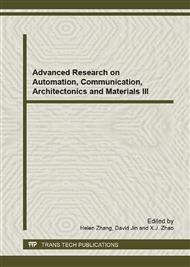[1]
XIA Yuming, WANG Weidong, and XU Zhiqiang, Numerical computation of laminar flow pipeline transport axial flow field, 2009 International Conference on Information Technology and Computer Science (ICITCS 2009), 2009, pp.196-199.
DOI: 10.1109/itcs.2009.179
Google Scholar
[2]
Xia Yuming and XU Zhiqiang, Electromagnetic Flowmeter Measurement and Numerical Computation of Laminar Flow Transport Pipeline Flow Quantity, 2009 Second International Symposium on Electronic Commerce and Security (ISECS 2009), 2009, pp.169-173.
DOI: 10.1109/isecs.2009.47
Google Scholar
[3]
Zhiqiang Xu, Yuming Xia, Numerical Simulation of Coal Water Mixture Pipeline Transport Axial Flow Field, 2008 International Conference on Computer Science and Information Technology (ICCSIT 2008), 2008, pp.243-246.
DOI: 10.1109/iccsit.2008.75
Google Scholar
[4]
XIA Yuming, TIAN Jinyun, XU Zhiqiang, WANG Weidong, Computational error of laminar flow pipeline transport axial flow field, 2009 International Conference on Computer Science and Information Technology (ICCSIT 2009), 2009, pp.635-639.
DOI: 10.1109/iccsit.2009.5234872
Google Scholar
[5]
R. O. Fox. Computational Models for Turbulent Reacting Flows. Cambridge University Press, Cambridge, England, (2003).
Google Scholar
[6]
W. Kraipech, A. Nowakowski, T. Dyakowski, et al. An investigation of the particle–fluid and particle–particle interactions on the flow within a hydrocyclone. Chem. Eng. J., 2005, 111: 189-197.
DOI: 10.1016/j.cej.2005.02.022
Google Scholar
[7]
Trong T. Bui. A Parallel, Finite Volume Algorithm for Large Eddy Simulation of Turbulent Flows. Technical Memorandum NASA/TM-1999-206570, (1999).
DOI: 10.2514/6.1999-789
Google Scholar
[8]
Jonas Bergstrom, Hannes Vomhoff. Experimental hydrocyclone flow field studies. Separation and Purification Technology, 2007, 53: 8-20.
DOI: 10.1016/j.seppur.2006.09.019
Google Scholar
[9]
H. Ibdir, H. Arastoopour. Modeling of multi-type particle flow using kinetic approach. AICHE Journal, (2005).
Google Scholar
[10]
Narasimha M, B rennan M S, Holtham P N. Numerical simulation of magnetite segregation in a dense medium cyclone. M inerals Engineering, 2006, 19: 1034-1047.
DOI: 10.1016/j.mineng.2006.03.013
Google Scholar


